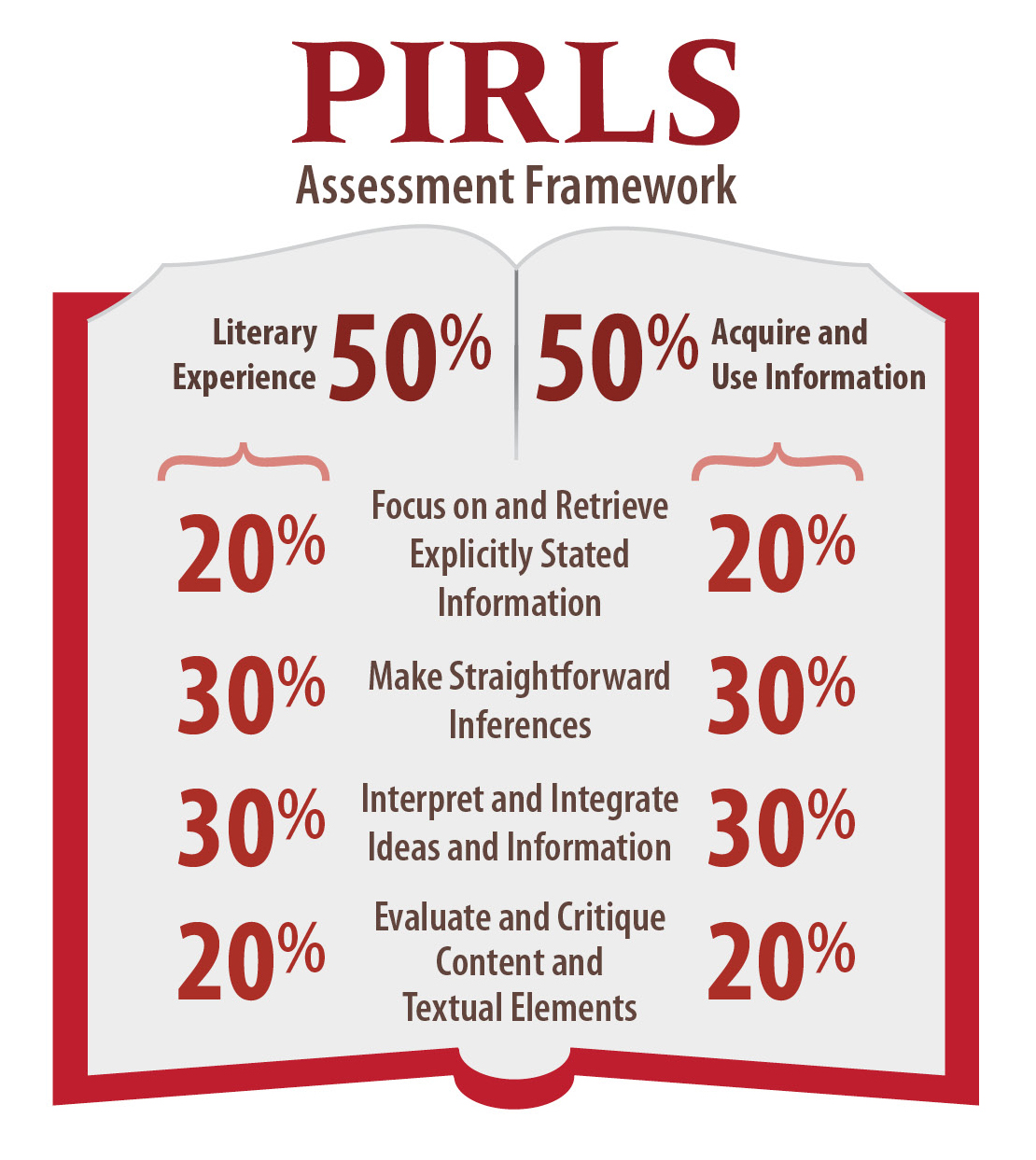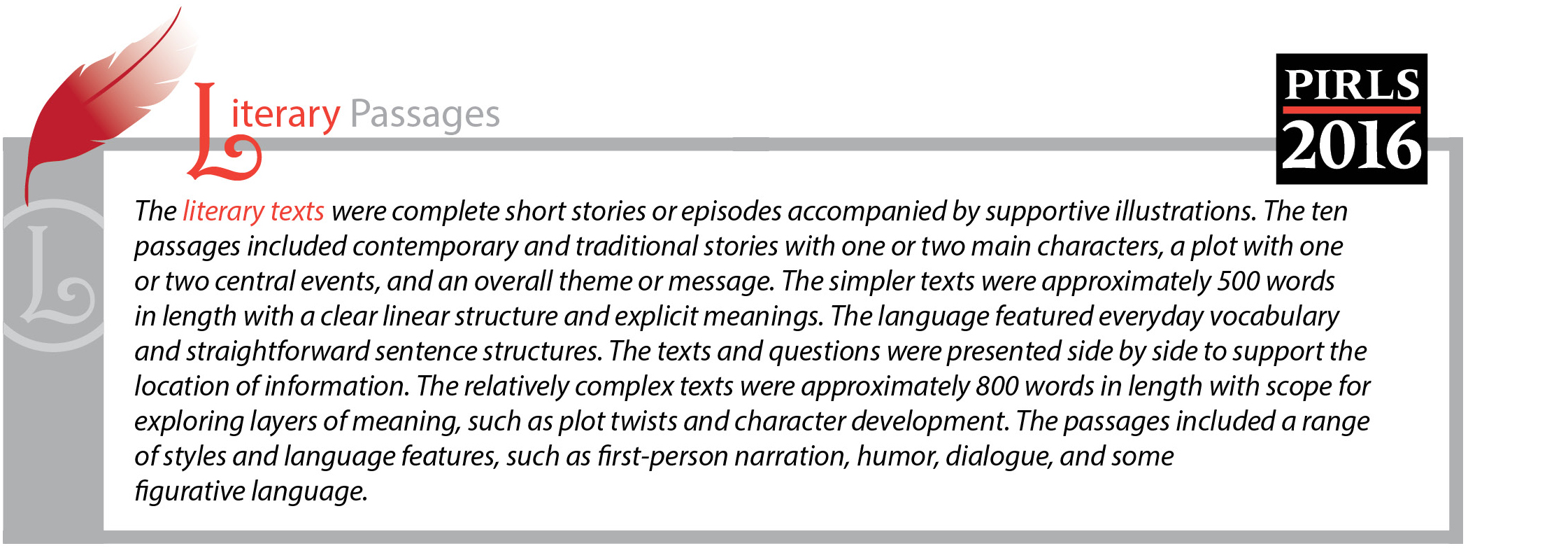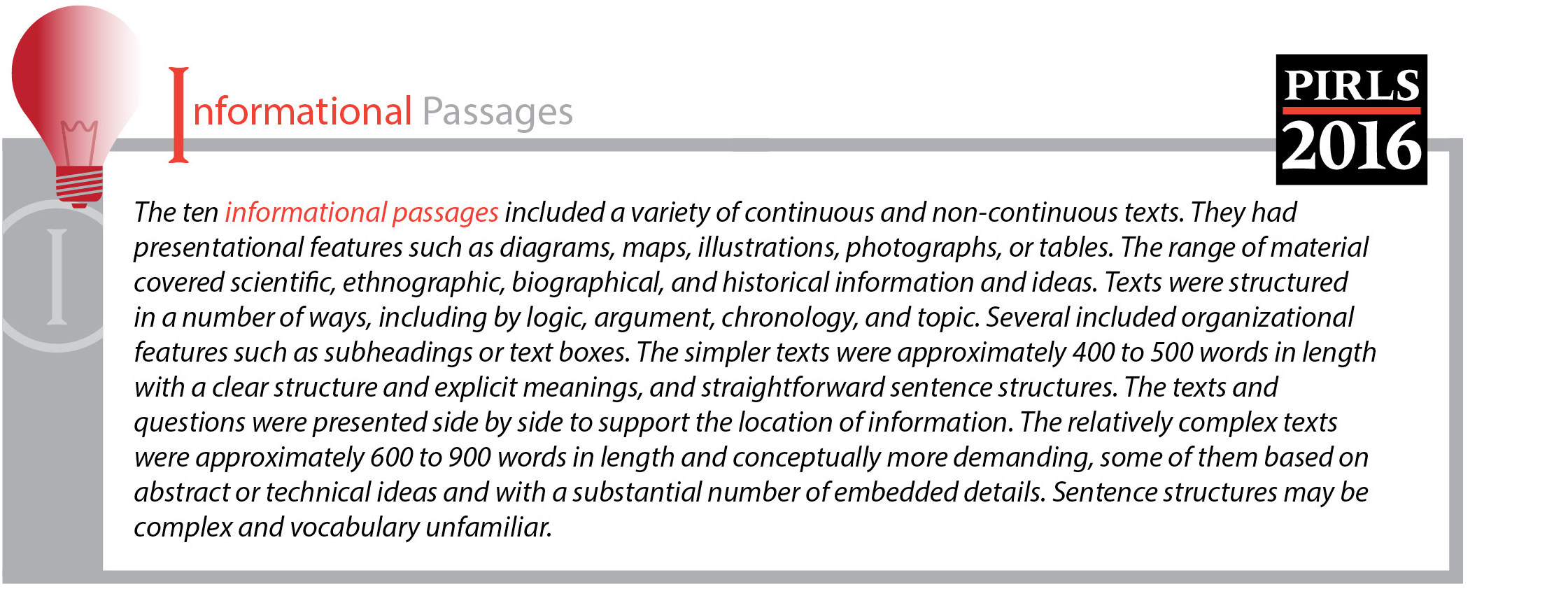The PIRLS 2016 International Benchmarks of Reading Achievement
Overview of the PIRLS 2016 Texts and Items

The texts and items used in PIRLS 2016 were selected and developed based on the PIRLS 2016 Assessment Framework. The framework describes the PIRLS view of reading as an interactive process between the text and the reader and describes the ways that PIRLS measures students’ reading achievement. It specifies that the assessment texts and items should cover in equal amounts the two purposes that account for most of the reading done by young students in and out of school:
- For literary experience
- To acquire and use information
Across the literary and informational texts, the PIRLS items measure four processes of comprehension: retrieving, straightforward inferencing, interpreting and integrating, and evaluating and critiquing.
For PIRLS 2016, the assessment was extended to include a less difficult assessment known as PIRLS Literacy. The purpose of the PIRLS Literacy assessment is to provide better measurement at the lower end of the PIRLS achievement scale.
The PIRLS Literacy assessment is equivalent to PIRLS in scope and reflects the same conception of reading as PIRLS, but in addition to passages in common with PIRLS it includes some less difficult texts. Including PIRLS and PIRLS Literacy, the 2016 assessment included 20 different passages: 8 only in PIRLS, 4 in both PIRLS and PIRLS Literacy, and 8 only in PIRLS Literacy. The reading passages and questions in common between the PIRLS and PIRLS Literacy assessments enable the two assessments to be linked, so that the PIRLS Literacy assessment results can be reported together with PIRLS assessment results and directly compared with them. The range of texts and items–from the relatively complex texts and items in PIRLS to the shared passages, to the relatively simpler passages in PIRLS Literacy–provided an excellent basis for the PIRLS 2016 scale anchoring analysis.
To provide examples of the assessment passages and items, five texts together with their associated items and scoring guides can be found in Appendix H. All five texts are designated as “restricted use,” which means that they are reproduced here with permission from the IEA. Any further reproduction or use of these passages requires permission from the IEA. Two of the passages in Appendix H are from PIRLS 2016, including “Macy,” a literary text about a teenage girl, and the informational text “The Green Sea Turtle’s Journey.” One passage, “Flowers on the Roof,” was included in both the PIRLS and PIRLS Literacy assessments. There also are two released passages from PIRLS Literacy, including “The Pearl,” which is a story about a boy who found a rare pearl, and “Rhinos,” which describes the relationship between rhinos and oxpecker birds. The PIRLS and PIRLS Literacy formats are different. The PIRLS texts were followed by the items, whereas the PIRLS Literacy texts were presented in a slightly larger font and the items were interleaved “side by side” within the texts.
Description of the Literary and Informational Texts
Consistent with the two reading purposes that provide the foundation of the PIRLS 2016 Assessment Framework, the scale anchoring analysis was conducted separately for the literary and informational texts and items. The assessment was divided equally between the two purposes, such that across PIRLS and PIRLS Literacy it included 10 literary texts and 10 informational texts.
Literary Reading
In literary reading, readers engage with the text to become involved in events, settings, actions, consequences, characters, atmosphere, feelings, and ideas, and to enjoy language.

Informational Reading
Informational texts are both read and written for a wide variety of functions. While the primary function is to provide information, depending on the objectives writers address their subject matter using a variety of formats (e.g., biography, persuasive essay, instructions, or argument).

Description of the PIRLS 2016 International Benchmarks
The interactive graphic shows the descriptions of the skills demonstrated by fourth grade students at each of the four International Benchmarks. Benchmark descriptions at each level are shown separately for literary and informational reading to reflect the varying demands that different types of texts present. With each reading purpose, the progression in reading comprehension processes is evident from benchmark to benchmark.

When reading relatively complex Literary Texts, students can:
- Interpret story events and character actions to describe reasons, motivations, feelings, and character development with full text-based support
- Begin to evaluate the effect on the reader of the author’s language and style choices
When reading relatively complex Informational Texts, students can:
- Distinguish and interpret complex information from different parts of text, and provide full text-based support
- Integrate information across a text to explain relationships and sequence activities
- Begin to evaluate visual and textual elements to consider the author’s point of view
When reading relatively complex Literary Texts, students can:
- Locate and distinguish significant actions and details embedded across the text
- Make inferences to explain relationships between intentions, actions, events, and feelings, and give text-based support
- Interpret and integrate story events and character actions, traits, and feelings as they develop across the text
- Recognize the use of some language features (e.g., metaphor, tone, imagery)
When reading relatively complex Informational Texts, students can:
- Locate and distinguish relevant information within a dense text or a complex table
- Make inferences about logical connections to provide explanations and reasons
- Integrate textual and visual information to interpret the relationship between ideas
- Evaluate and make generalizations about content and textual elements
When reading a mix of simpler and relatively complex Literary Texts, students can:
- Independently locate, recognize, and reproduce explicitly stated actions, events, and feelings
- Make straightforward inferences about the attributes, feelings, and motivations of main characters
- Interpret obvious reasons and causes, recognize evidence, and give examples
- Begin to recognize language choices
When reading a mix of simpler and relatively complex Informational Texts, students can:
- Locate and reproduce two or three pieces of information from text
- Make straightforward inferences to provide factual explanations
- Begin to interpret and integrate information to order events
When reading predominantly simpler Literary Texts, students can:
- Locate and retrieve explicitly stated information, actions, or ideas
- Make straightforward inferences about events and reasons for actions
- Begin to interpret story events and central ideas
When reading predominantly simpler Informational Texts, students can:
- Locate and reproduce explicitly stated information from text and other formats (e.g., charts, diagrams)
- Begin to make straightforward inferences about explanations, actions, and descriptions

